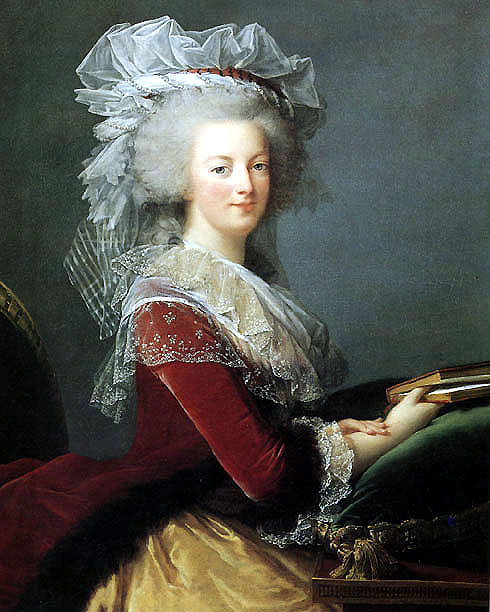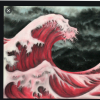 |
  |

02-11-2013, 11:16 PM
|
 |
I said it, so I feel it, dick
|
|
Join Date: Jul 2004
Location: Here
|
|
 Historic colors and dyes
Historic colors and dyes
Puce has apparently has been in and out of fashion for centuries. I cannot find anything telling me how it was made, however, so no idea if anyone has tried to recreate it.
This dress fragment of Marie Antoinette's is described as being puce (sold at Christie's), but I must assume that the purple/scarlet has faded out over time...or is it more likely that purple/scarlet was added over time and that what we know as puce is not at all what it started out as? Since today there is such a large range of colors called puce I wonder if we can even know what it was originally?

In this painting she may have been wearing puce, or it may be my monitor, or it may be that paint fades funny over time. I just don't know!

Any fave historic colors, or questions, or mysteries or interesting facts to share?
|

02-11-2013, 11:25 PM
|
 |
I said it, so I feel it, dick
|
|
Join Date: Jul 2004
Location: Here
|
|
 Re: Historic colors and dyes
Re: Historic colors and dyes
I wish I could find a large image of this, to see the trim color better

|

02-11-2013, 11:28 PM
|
 |
I said it, so I feel it, dick
|
|
Join Date: Jul 2004
Location: Here
|
|
 Re: Historic colors and dyes
Re: Historic colors and dyes
Judi Dench in puce

I'll stop now
|

02-11-2013, 11:50 PM
|
 |
Admin of THIEVES and SLUGABEDS
|
|
|
|
 Re: Historic colors and dyes
Re: Historic colors and dyes
Puce is the word for flea in French. The origin story I heard is that it was named after the color left behind on sheets after you squash a flea on them and then wash the sheets. So like a set blood stain, basically.
I'm a fan of Maya Blue, a pigment made by mixing the sediment of the soaked and dried Aņil plant with a white clay called palygorskite and heating them up at a low temperature for a long time. Once its cured, the result is a beautiful turquoise color that is so fast sun and rain can't fade it. Neither can chemical solvents. It was used through early colonial times and then the recipe was lost. It's only within the last 20 years or so that researchers have been able to rediscover its ingredients.
The color was had ritual significance particularly in regards to human sacrifice. Priests burned incense for hours and actually created Maya Blue in the incense burners. They would then paint objects and victims with the pigment and sacrifice the whole lot. Here's a mural from Bbonampak, Mexico, depicting just such a sacrificial event with a gorgeous Maya Blue background:
Maya blue sacrifice Bbonampak Mexico..jpg

|

02-12-2013, 12:51 AM
|
 |
I said it, so I feel it, dick
|
|
Join Date: Jul 2004
Location: Here
|
|
 Re: Historic colors and dyes
Re: Historic colors and dyes
Is the color available commercially at all? It's beautiful!
|

02-12-2013, 01:20 AM
|
 |
Admin of THIEVES and SLUGABEDS
|
|
|
|
 Re: Historic colors and dyes
Re: Historic colors and dyes
Not in its original form, as far as I know, although of course chemical dyes that seek to replicate the color abound. The Aņil plant makes an indigo dye just by itself that I believe is still in use today.
|

02-12-2013, 01:47 AM
|
 |
Tellifying
|
|
Join Date: Oct 2004
Location: Northern Virginia
|
|
 Re: Historic colors and dyes
Re: Historic colors and dyes
I had listened to a podcast from NYC Radiolab which focused on colors. One of the segments dealt with the use of color in Homer's Odyssey. A Homer enthusiast had noted that Homer used very odd descriptions for colors, such as "wine dark sea" or wool being violet.
This enthusiast then decided to catalog all the uses of color in the Odyssey and determined that some colors were definitely used more often, such as black and white. While some other colors were used rarely.
But one color was notable in its absence. And that was the color "blue".
It was very odd that "blue" should not mentioned at all. Not even once. The enthusiast concluded that Homer was color blind.
However, other scholars were not satisfied with that theory and proceeded to study other works by Homer and his contemporaries. To their amazement, "blue" was not used in any of the works they studied.
They expanded the study to other works of literature from other culture and discovered that "blue" was not used by any culture in their early literature. This was not only Western cultures, but Eastern ones as well.
Eventually, the color "blue" did start showing up in literature, but only after a significant period of development in the culture's history.
What to make of this?
The theory they discussed in the podcast is that "blue" is not really a naturally occurring color. It's pretty rare outside of man-made dyes. And until the society had discovered how to make blue-colored dyes, there was simply no need for the word "blue". Thus, the word didn't come into existence until later.
Of course, the big problem with this theory is the sky. The sky is just about the bluiest blue that ever blued. And the sky's been around for pretty much forever, so how come no word was ever used to describe that color?
One linguist suggested that it is simply because the sky is everywhere at all times. He told how he would play the color game with his two-year old daughter. You know the game, "What color is this apple?" or "What color is this carrot?"
He did this but took pains to avoid using anything blue. After a few months of this and his daughter demonstrated that she knew her colors, he pointed at the sky and asked "What color is that?"
She didn't answer. She refused to answer. Wouldn't even try.
After a few weeks of getting her to answer, she finally did....with a hesitant "white?" Sometimes she said "grey". Until eventually he taught her that it was blue.
I don't know how valid this theory is or even the historical accuracy of the story. But, I do know it was one very interesting podcast.
__________________

|
|
Thanks, from:
|
Adam (02-12-2013), beyelzu (02-12-2013), ceptimus (01-12-2022), Crumb (02-12-2013), curses (02-12-2013), Ensign Steve (02-12-2013), Janet (02-13-2013), LadyShea (02-12-2013), lisarea (02-12-2013), livius drusus (02-12-2013), Pan Narrans (02-12-2013), Qingdai (02-12-2013), S.Vashti (02-13-2013), Watser? (02-12-2013)
|

02-12-2013, 03:17 AM
|
 |
Coffin Creep
|
|
Join Date: Sep 2004
Location: The nightmare realm
|
|
 Re: Historic colors and dyes
Re: Historic colors and dyes
I've heard that before, but it doesn't seem true to me.
I doubt that it would have seemed true to King Tutankhamun either.
__________________
Much of MADNESS, and more of SIN, and HORROR the soul of the plot.
|

02-12-2013, 03:40 AM
|
 |
Dogehlaugher -Scrutari
|
|
Join Date: Jan 2007
Location: Northwest
Gender: Female
|
|
 Re: Historic colors and dyes
Re: Historic colors and dyes
Color is a culturally defined concept, just like time and many other things we take for granted.
There are some cultures that see what we call blue to be a type of green, but might have many other definitions of green that we don't distinguish. Then there are artists who spend a whole lot of time distinguishing between colors, shades and tones. Use it or lose it, baby.
I always thought of puce as a combination of orange and baby blue, if that helps any.
__________________
Ishmaeline of Domesticity drinker of smurf tears
|

02-12-2013, 04:26 AM
|
 |
I said it, so I feel it, dick
|
|
Join Date: Jul 2004
Location: Here
|
|
 Re: Historic colors and dyes
Re: Historic colors and dyes
Many people think puce is a green (would orange and baby blue make a green/brown?). Even today puce ranges from a violet color to Pantone's greyed out eggplanty type color

Quote:
One linguist suggested that it is simply because the sky is everywhere at all times. He told how he would play the color game with his two-year old daughter. You know the game, "What color is this apple?" or "What color is this carrot?"
He did this but took pains to avoid using anything blue. After a few months of this and his daughter demonstrated that she knew her colors, he pointed at the sky and asked "What color is that?"
She didn't answer. She refused to answer. Wouldn't even try.
After a few weeks of getting her to answer, she finally did....with a hesitant "white?" Sometimes she said "grey". Until eventually he taught her that it was blue.
|
If he didn't teach her what the color blue was how would she know? You have to teach kids that carrots are orange and stuff.
|

02-12-2013, 04:54 AM
|
 |
Dogehlaugher -Scrutari
|
|
Join Date: Jan 2007
Location: Northwest
Gender: Female
|
|
 Re: Historic colors and dyes
Re: Historic colors and dyes
A light brown greenish color, is what I was thinking. I got if from some long out of date children's book from the 1970s about tie dying a girl's shoes.
I always thought it'd look like this, but perhaps I'm uncultured.

__________________
Ishmaeline of Domesticity drinker of smurf tears
|

02-12-2013, 06:23 AM
|
 |
A Very Gentle Bort
|
|
Join Date: Jan 2005
Location: Bortlandia
Gender: Male
|
|
 Re: Historic colors and dyes
Re: Historic colors and dyes
The turn of this thrad reminded me of a video/experiment:
Quote:
In the English language (and most languages), there are distinct words for “green” and “blue. Therefore, it’s very easy for most people to detect the blue square in the right ring, but difficult to detect the slightly different green square in the left one.
However, when scientists visited a tribe in northern Namibia that has a completely different way of grouping and naming colors, they found that the exact opposite was true — the tribe members picked out the slightly different green square easily, while struggling to see the blue one.
|
__________________
\V/_ I COVLD TEACh YOV BVT I MVST LEVY A FEE
|

02-12-2013, 12:48 PM
|
 |
I said it, so I feel it, dick
|
|
Join Date: Jul 2004
Location: Here
|
|
 Re: Historic colors and dyes
Re: Historic colors and dyes
I cannot find the different green square at all
|

02-12-2013, 12:49 PM
|
 |
Fishy mokey
|
|
Join Date: Jul 2006
Location: Furrin parts
|
|
 Re: Historic colors and dyes
Re: Historic colors and dyes
I read recently as well that a lot of languages don't differentiate between green and blue.
Anyway, one of the most famous dyes from antiquity: Tyrian purple
|

02-12-2013, 01:35 PM
|
 |
I said it, so I feel it, dick
|
|
Join Date: Jul 2004
Location: Here
|
|
 Re: Historic colors and dyes
Re: Historic colors and dyes
Q, I love your puce. That's the color I painted my pantry
|

02-12-2013, 02:45 PM
|
 |
puzzler
|
|
Join Date: Aug 2004
Location: UK
|
|
 Re: Historic colors and dyes
Re: Historic colors and dyes
Quote:
Originally Posted by LadyShea

I cannot find the different green square at all
|
It's the one where the hour hand on a clock would point at about 10:30
I suppose I would just call it, 'a very slightly different shade of green', but I certainly don't have different names to call the two greens.
__________________
|

02-13-2013, 11:53 AM
|
 |
Astroid the Foine Loine between a Poirate and a Farrrmer
|
|
Join Date: Feb 2011
Gender: Male
|
|
 Re: Historic colors and dyes
Re: Historic colors and dyes
Here's a good one: the color "Tekhelet". It features about 50 times in the Tanakh, and it is generally translated as "Blue" in the septaguint. The tapestries in the Temple were "Tekhelet", as were the robes of the high priests. On the edges of traditional robes, a few of the tassles (tzitzit) were supposed to be colored "Tekhelet" too. It is explained that "Tekhelet" can only be obtained from the "Khillazon", a word that has come to mean snail in modern hebrew. It goes on to point out that other sources of blue such as the plant "kella-lan" are not to be used.
Unfortunately, the color "Tekhelet" was lost in antiquity.
Now Jewish rabbis are not the kind of people who let that kind of thing get them down, and diligent research has been going on for hundreds of years, trying to identify the "Khillazon" and re-discover the color "Tekhelet"
The Talmud gives us the following clues:
Its body is similar to the sea.
Its form is like a fish.
It comes up once in 70 years,
With its "blood" one dyes tekhelet,
Therefore: It is expensive.
Other criteria (with Talmudic references):
The fishers of the khillazon are from Haifa to the ladder of Tyre (Shabbat 26a)
The color of the khillazon dye is identical to that produced from the dye of the kela ilan plant (Indigofera tinctoria), which served as a counterfeit source of the dye (Baba Metzia 61b)
Cracking open the shell of the khillazon on Shabbat violates the laws of Shabbat (Shabbat 75a)
The shell of the khillazon grows together with it (Midrash Song of Songs Rabbah 4:11)
It is an invertebrate (Jerusalem Talmud Sabbath 1:38a)
A dye produced from the Cuttlefish was proposed for a while, but as it turned out, that dye was really just prussian blue, with the cuttlefish only providing the organic material.
Rav Herzog finally seems to have cracked the problem in 1913: Murex Trunculus, a type of sea-snail, can be used to produce a midnight blue with a hint of purple. Herzog was unable to consistently produce blue, however, as sometimes the result was purple. It was not until the 1980's that someone discovered that if you expose a solution of the dye to sunlight, it consistently produced the midnight blue.
Then, in 2011, Zvi C. Koren analyzed a tiny sample of "Tekhelet" found in Massada and found it to be derived from Murex. Tekhelet, which is shown as light blue in the Israeli flag, was actually a midnight blue with a hint if purple. It is also pretty close to Indigo which the writings warned against as not being kosher.

|

02-13-2013, 03:42 PM
|
 |
California Sober
|
|
Join Date: Jul 2004
Location: Silicon Valley
Gender: Bender
|
|
 Re: Historic colors and dyes
Re: Historic colors and dyes
This isn't so much a fabric or a dye, per se, but shut up. It's a technique. I saw it on the pinterest.
Quote:
|
Shibori is a Japanese term for methods of dyeing cloth by binding, stitching, folding, twisting, and compressing. In Japan, the earliest known example of cloth dyed with the shibori technique dates back to the 8th century where indigo was the main dye used. We were immediately inspired by this fascinating technique, it’s history and beauty. After much research, we decided to tackle 3 techniques of Shibori dyeing with an Indigo Tie Dye Kit, a few old white shirts and scarves, and several household items.
|
setup:
results:
more at link:
DIY Shibori – Honestly WTF
|

02-14-2013, 05:18 AM
|
 |
rude, crude, lewd, and unsophisticated
|
|
Join Date: Jul 2004
Location: Puddle City, Cascadia
Gender: Male
|
|
 Re: Historic colors and dyes
Re: Historic colors and dyes
In my wife's spinning years, she at one point took a class on using natural dyes. Indigo was the test dye and she came home with skeins of loverly blues and lots of newly redyed blue clothing items.
I was trying to remember what dye it was that was rendered from iris. This site pegged it for me...the blue dye from the root of iris pseudocorus.
I can't help with the puce, though. I'm with Q, though, on the color.
|

02-14-2013, 06:15 AM
|
 |
Dark Lord, on the Dark Throne
|
|
|
|
 Re: Historic colors and dyes
Re: Historic colors and dyes
Quote:
Originally Posted by Watser?

I read recently as well that a lot of languages don't differentiate between green and blue.
Anyway, one of the most famous dyes from antiquity: Tyrian purple |
This is my favorite from antiquity.
Back when I was deconstructing fundamentalist arguments about fulfilled prophecies, there were so many about Tyre that I had to become familiar with the murex snail, and its role in making Tyre so rich. Imperial Tyrian purple was such a conspicuous commodity in Phoenicia, Roman times, and Byzantine times.
Today, however, it just seems like an awful waste of some harmless yet beautiful snails..... 
__________________
In the land of Mordor, where the shadows lie...
Last edited by Sauron; 02-14-2013 at 06:28 AM.
|

02-14-2013, 10:27 AM
|
 |
Astroid the Foine Loine between a Poirate and a Farrrmer
|
|
Join Date: Feb 2011
Gender: Male
|
|
 Re: Historic colors and dyes
Re: Historic colors and dyes
Hahaha I just compared Watsers article with what I was describing... seems ot me that Tekhelet IS Tyrian purple 
|

02-14-2013, 12:16 PM
|
 |
Fishy mokey
|
|
Join Date: Jul 2006
Location: Furrin parts
|
|
 Re: Historic colors and dyes
Re: Historic colors and dyes
I was kinda wondering about that.
|

02-17-2013, 05:25 AM
|
 |
NeoTillichian Hierophant & Partisan Hack
|
|
Join Date: Dec 2005
Location: Iowa
Gender: Male
|
|
 Re: Historic colors and dyes
Re: Historic colors and dyes
Puce is not a real color. It is entirely fictional, just like chartreuse. You guys are so gullible.
__________________
Old Pain In The Ass says: I am on a mission from God to comfort the afflicted and afflict the comfortable; to bring faith to the doubtful and doubt to the faithful. 
|

01-11-2022, 06:14 PM
|
 |
puzzler
|
|
Join Date: Aug 2004
Location: UK
|
|
 Re: Historic colors and dyes
Re: Historic colors and dyes
A Google search gives the prominent result: 'The hex code for puce is #CC8899.' If I've got my HTML right, this text should be displayed using that code. Looks a bit too light to me though - a sort of dark pink rather than Wikipedia's description: Puce is a dark red or purple brown color,[1] a brownish purple[2] or a "dark reddish brown."[3]
Here's the same #CC8899 code on a black background. Still looks like a dark pink. 
__________________
|

03-16-2022, 04:22 PM
|
 |
Member
|
|
|
|
 Re: Historic colors and dyes
Re: Historic colors and dyes
While looking into the Kingdom of Kush for inspiration, I found a guide to the colors of ancient Egypt.
Colors of Ancient Egypt
Egyptian blue - Wikipedia
"Egyptian blue, also known as calcium copper silicate (CaCuSi4O10 or CaOCuO(SiO2)4 (calcium copper tetrasilicate)) or cuprorivaite, is a pigment that was used in ancient Egypt for thousands of years. It is considered to be the first synthetic pigment.[1] It was known to the Romans by the name caeruleum. After the Roman era, Egyptian blue fell from use and, thereafter, the manner of its creation was forgotten. In modern times, scientists have been able to analyze its chemistry and reconstruct how to make it."
"Egyptian blue's extremely powerful and long-lived infrared luminescence under visible light has enabled its presence to be detected on objects which appear unpainted to the human eye.[24] This property has also been used to identify traces of the pigment on paintings produced as late as the sixteenth century, long after its use was presumed to have died out.[25] The luminescence in the near-infrared, where neither fat nor hemoglobin show high absorption coefficients, in conjunction with the capacity of Egyptian blue to delaminate by splitting into nanosheets after immersion in water, also indicates it may have several high-technology applications, such as in biomedicine (e.g. bioimaging), telecommunications, laser technology, and security inks."

|
|
Currently Active Users Viewing This Thread: 1 (0 members and 1 guests)
|
|
|
| Thread Tools |
|
|
| Display Modes |
 Linear Mode Linear Mode
|
 Posting Rules
Posting Rules
|
You may not post new threads
You may not post replies
You may not post attachments
You may not edit your posts
HTML code is Off
|
|
|
All times are GMT +1. The time now is 12:49 PM.
|
|
 |
|